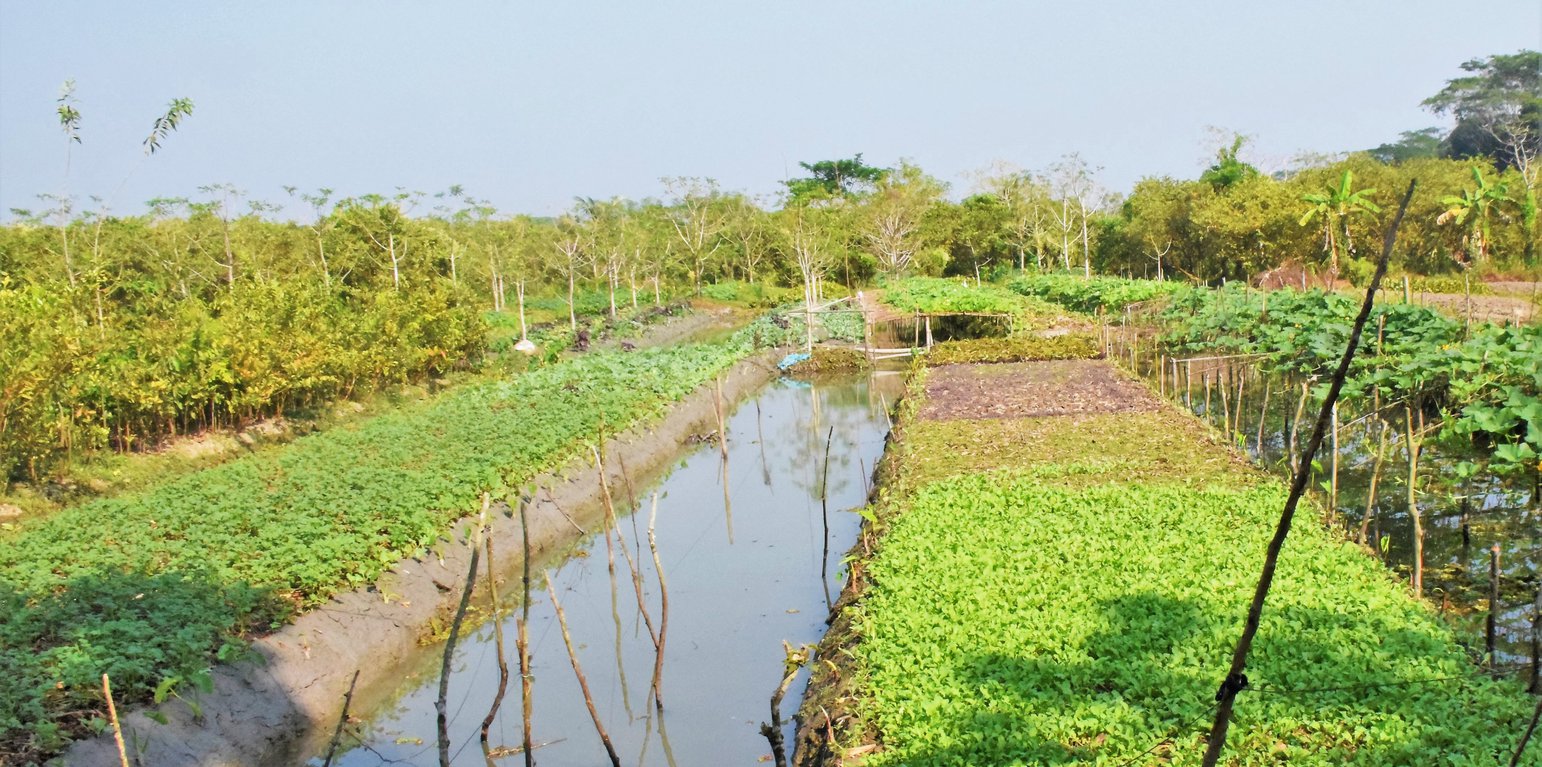



Marshy land covers most of the area of southern Bangladesh in the estuaries of the big rivers, including Swarupkathi Upazila. This area typically floods for more than 9 months, is perennially wet, and is covered by Hogla (Typha), Reed plant, and weeds. Crop cultivation has been difficult due to unfavourable drainage conditions. Local people previously cultivated paddy only in small areas by clearing the swamp vegetation. Now, however, some of the marshy land has been converted to a dyke and ditch multi-cropping system, which has been practiced for the last 200 years. Through this practice, the marshlands have provided valuable harvests for generations and currently yield vegetables, fruits, timber and fishes for farmers and that support local livelihoods. The marshland ecosystem, that converted to terrestrial ecosystem now support habitat for a wide range of flora and fauna. The technology reduces the pressure on arable land through construction of dykes which also plays a crucial role in flood mitigation. The continuous series of dykes and ditches with diverse vegetation increases the aesthetic beauty of the region and conserve biodiversity as well.
The dykes are elevated beds of soil constructed to 4-6 feet height and 12-14 feet width. The dykes are constructed with soils collected from ditches and on the top of the bed water hyacinth composed are used. Along with increasing fertility, water hyacinth compost also increases the soil holding capacity of the dykes. Though water hyacinth is normally one of the most dangerous invasive species, it can be converted to useful resource by this system. The ditches are 10-11 feet wide canals and deep enough for fish culture. According to size of land owned by farmer the length of each dyke and ditch varies. All the ditches are interconnected with a regular flow of water. Once the dyke preparation is complete, crops including brinjal (eggplant), turnip, red amaranth, coriander, spinach, cowpea, chili, cornflower, tomato, papaya are planted. On the bed, 1 foot wide drain is constructed after every 3 feet intervals. Creepers and vines are planted on sticks along the sides of the dyke to prevent erosion. Trellis crops like bottle gourd, bitter gourd, ash gourd, sweet gourd, cucumber, etc. are cultivated in between two dykes and over the ditches. Guava, Hog plum, banana, lemon, pineapples and other fruit trees planted are in the bed after three years of establishment. Timber trees are also introduced in the dykes over time though some beds are only managed for crop cultivation. Through this way, they establish a multi-crop and agro-forestry system. In the ditches, farmers cultivate local fish varieties that generate extra income for them. Water hyacinth also managed in the ditch that used as fertilizer in the bed. Farmer add soil to the dyke from the ditches once in every year to raise the dyke and make it stable. The local community also developed a large floating market of guava, which now attracts tourism in this area and facilitates alternate income.
The initial investment of establishing dyke and ditch technology is expensive due to huge labour requirement for dyke preparation and often difficult for farmers to manage the required money. Usually they take loans from neighbours or micro credit organizations with high interest to initiate the work. Almost 80% of the households are involved with micro credits in Swarupkathi because loans from the national bank is much more time-consuming. If the farmers can get easier access to loan and marketing facilities from the government, they will benefit more from the dyke and ditch system.
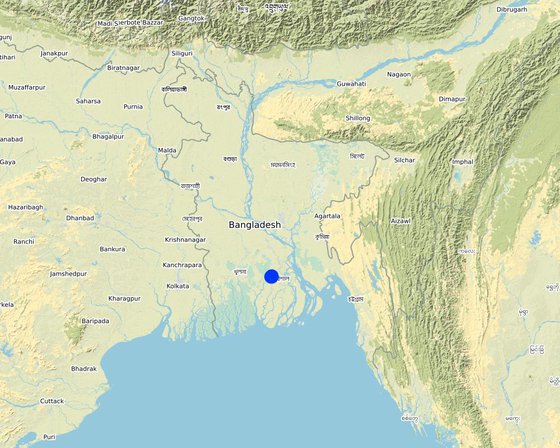
ສະຖານທີ່: Atghor Kuriana, Swarupkathi, Pirojpur, Barishal Division, ບັງລາເດດ
ຈໍານວນ ພື້ນທີ່ ທີ່ໃຊ້ ເຕັກໂນໂລຢີ ທີ່ໄດ້ວິເຄາະ: 10-100 ພຶ້ນທີ່
ການແຜ່ກະຈາຍຂອງເຕັກໂນໂລຢີ: ແຜ່ຂະຫຍາຍຢ່າງໄວວາໃນພື້ນທີ່ (approx. 100-1,000 ກມ 2)
ຢູ່ໃນເຂດປ່າສະຫງວນທີ່ບໍ?: ບໍ່ແມ່ນ
ວັນທີຂອງການປະຕິບັດ: ຫຼາຍກ່ອນ 50 ປີຜ່ານມາ (ແບບພື້ນບ້ານ)
ປະເພດຂອງການນໍາສະເໜີ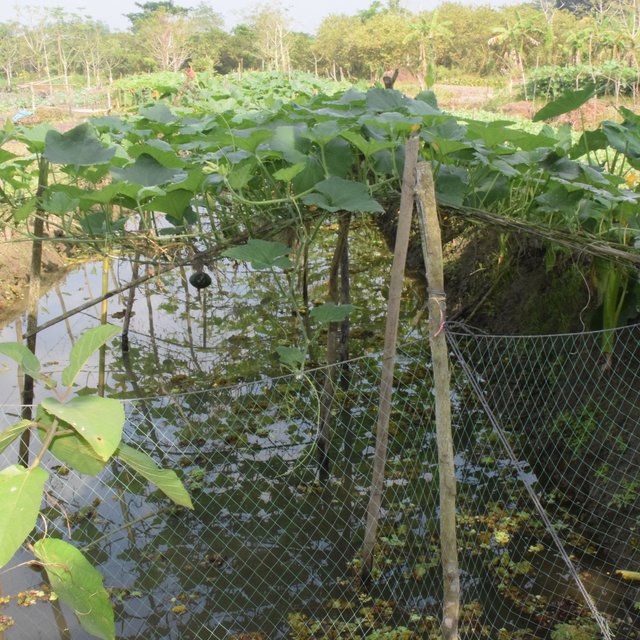
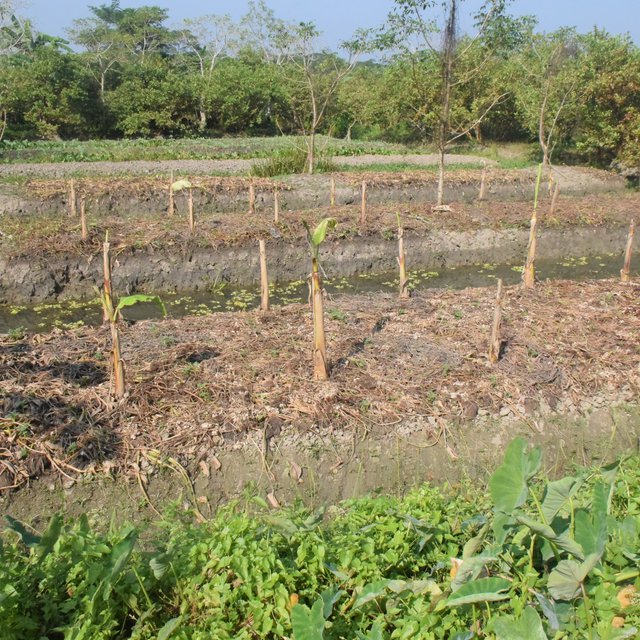





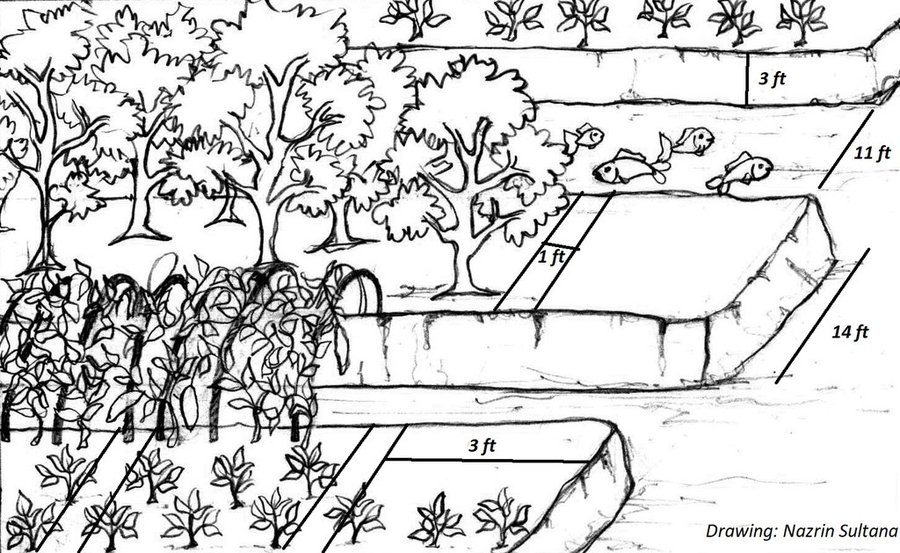
| ລະບຸ ປັດໃຈ ນໍາເຂົ້າ ໃນການຜະລີດ | ຫົວໜ່ວຍ | ປະລິມານ | ຕົ້ນທຶນ ຕໍ່ຫົວໜ່ວຍ (BDT) | ຕົ້ນທຶນທັງໝົດ ຂອງປັດໃຈຂາເຂົ້າ ໃນການຜະລິດ (BDT) | % ຂອງຕົ້ນທຶນທັງໝົດ ທີ່ຜູ້ນໍາໃຊ້ທີ່ດິນ ໃຊ້ຈ່າຍເອງ |
| ແຮງງານ | |||||
| Earth work (dyke preparation, bed leveling with water hyacinth compost, drain preparation on bed) | person-days | 200.0 | 500.0 | 100000.0 | 100.0 |
| Cultivation | person-day | 100.0 | 500.0 | 50000.0 | 100.0 |
| Weeding | person-day | 60.0 | 500.0 | 30000.0 | 100.0 |
| ອຸປະກອນ | |||||
| Spade | pieces | 2.0 | 250.0 | 500.0 | 100.0 |
| Weeder (manual weeding tool) | pieces | 2.0 | 150.0 | 300.0 | 100.0 |
| Bucket | pieces | 2.0 | 150.0 | 300.0 | 100.0 |
| Net (to support trellis crops cultivation in between dykes)) | kg | 20.0 | 60.0 | 1200.0 | 100.0 |
| Bamboo sticks (to support the nets and creepers vegetable) | pieces | 200.0 | 2.0 | 400.0 | 100.0 |
| ວັດສະດຸໃນການປູກ | |||||
| Seeds (needed over first 2-3 years of establishment) | kg | 0.5 | 2000.0 | 1000.0 | 100.0 |
| Seedling (needed over first 2-3 years of establishment) | pieces | 300.0 | 20.0 | 6000.0 | 100.0 |
| ຝຸ່ນ ແລະ ຢາຊີວະພາບ | |||||
| T.S.P | kg | 66.0 | 22.0 | 1452.0 | 100.0 |
| Urea | kg | 66.0 | 16.0 | 1056.0 | 100.0 |
| MoP | kg | 22.0 | 15.0 | 330.0 | 100.0 |
| Pesticides | litre | 1.0 | 5000.0 | 5000.0 | 100.0 |
| ຕົ້ນທຶນທັງໝົດ ໃນການຈັດຕັ້ງປະຕິບັດ ເຕັກໂນໂລຢີ | 197'538.0 | ||||
| ຄ່າໃຊ້ຈ່າຍທັງໝົດ ສຳລັບການສ້າງຕັ້ງເຕັກໂນໂລຢີ ເປັນສະກຸນເງີນໂດລາ | 2'351.64 | ||||
| ລະບຸ ປັດໃຈ ນໍາເຂົ້າ ໃນການຜະລີດ | ຫົວໜ່ວຍ | ປະລິມານ | ຕົ້ນທຶນ ຕໍ່ຫົວໜ່ວຍ (BDT) | ຕົ້ນທຶນທັງໝົດ ຂອງປັດໃຈຂາເຂົ້າ ໃນການຜະລິດ (BDT) | % ຂອງຕົ້ນທຶນທັງໝົດ ທີ່ຜູ້ນໍາໃຊ້ທີ່ດິນ ໃຊ້ຈ່າຍເອງ |
| ແຮງງານ | |||||
| Dyke management (add soil and water hyacinth to the dyke, bed leveling, drainage system on bed) | person-days | 66.0 | 500.0 | 33000.0 | 100.0 |
| ອຸປະກອນ | |||||
| Spade | pieces | 2.0 | 250.0 | 500.0 | 100.0 |
| Bucket | pieces | 2.0 | 150.0 | 300.0 | 100.0 |
| ຕົ້ນທຶນທັງໝົດ ທີ່ໃຊ້ໃນການບໍາລຸງຮັກສາ ເຕັກໂນໂລຢີ | 33'800.0 | ||||
| ຄ່າໃຊ້ຈ່າຍທັງໝົດ ສຳລັບການບົວລະບັດຮກສາເຕັກໂນໂລຢີ ເປັນສະກຸນເງີນໂດລາ | 402.38 | ||||
economic disparities decreased as marginal and landless farmers get the opportunity to grow crops on dykes and fish in ditches
through ditch and dyke cultivation technique local community get access to vegetable and fish source
local farmers are now forming groups and working together to transport their crops to market
landless farmers get opportunity to work as paid labor
evaporation decreased due to the presence of vegetation in dykes
Soil moisture decreased in dykes and before it was too swampy for agricultural activities